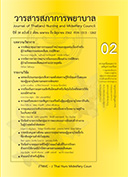Improvement of Discharge Planning and Continuing Care for Vascular Surgery Patients: A Case Study
Keywords:
discharge planning, continuing care, vascular surgery patients, case studyAbstract
Vascular surgery patients are prone to developing complications, which could result in high mortality risks. For this reason, such patients need to be treated in tertiary hospitals, where specialists and well-trained nurses play primary roles in planning their discharges and continuing care. It is necessary that the medical staff assess the patients’ conditions, provide them with proper care and plan their discharges with their family caregivers, to enable the patients to perform specifc self-care activities, such as caring for their surgical wounds or foot ischaemia, preventing disease-specifc risks and observing any abnormalities that would require urgent visits to the physicians. Without thorough planning and post-discharge follow-ups, the patients would have no reliable self-care consultants and could employ improper self-care methods, which
might result in escalating pain or even death.
Improvement to discharge and continuing care planning is, therefore, of critical importance, as it leads to additional channels for post-discharge monitoring. Through these channels, nurses are able to advise the patients and address their self-care problems in a timely manner, thereby minimising negative effects on the patients. This study has helped the researcher build a better knowledge of common post-discharge self-care
problems, which could be applied to improving a more comprehensive self-care system for other patients.
This article presents concepts related to nurses’ roles in discharge and continuing care planning, two important processes that could be contribute to positive outcomes in the treatment of vascular surgery patients.
Downloads
References
dyslipidemiaforatheroscleroticcardiovasculardisease
prevention.PathumThani:A-PlusPR;2016.(inThai)
2.Nursing services division Songklanagarind hospital. Medical record surgeryward.1 out of 5 major diseases
in surgical ward. Songkhla: Hospital; 2012.
3. Norgren L, HiattW, DormandyJ, Nehler M, Harris K, Fowkes F, et al. Inter - society consensus for the
management of peripheral arterial disease (TASC II). J Vasc Surg. 2007; 45(1):5 - 67.
4.Chinsakchi K., Wongwanit C., Pootracool P. KermthanasawatN.AppliedVascularSurgeryVolume1 Common Problems in Vascular Surgery.2nd ed. Bangkok: krungthephwechasarn; 2014. (in Thai)
5. Ruangwiset R, Wanitkun N, Danidusadeekul S, Wongkongkam K & Chinsakchi K. Predictive factors
in peripheral arterial occlusive disease patients’ recuperation after endovascular surgery. Thai Journal of Nursing Council 2017; 32(2):79-94. (in Thai)
6.Srisamai S, Ua-Kit N, Naveecharern R. Selected factors associated with health related quality of life in aorticaneurysmpatientsaftersurgery.Songklanagarind Journal of Nursing 2014; 34(2): 17-38. (in Thai)
7.Moonthee W, Monkong S, Sirapo-ngam Y, Leelacharas S. Impact of transitional care programme and family
caregiversonstrokepatients’routineactivityperformance, complications, and satisfaction. Thai Journal of Nursing Council 2016; 31(1):95-110. (in Thai)
8. HealthcareAccreditationInstitute(PublicOrganisation). HAStandardHA4thEdition.Nonthaburi: donebooks
company; 2017. (in Thai)
9. Kusuti S ,Wongsa P, Feukfon K. Effects of discharge planningonqualityoflifeandphysicalfunctionamong
patients receiving total knee arthroplasty surgery Chiangrai Prachanukroh hospital. Nursing Public Health andEducation Journal 2017; 18 (3):63-72. (in Thai)
10.P.Songwathana. Discharge planning and continuing ofcare:conceptandevidencedbasedpractice.[internet]. Songkhla : Faculty of Nursing, Prince of Songkla University; 2016 [cited 2018 Aug 17]. Availale from: https://pingpdf.com
11.Continuing care unit Siriraj hospital.Continuous care guidelines.[internet]. Bangkok: Siriraj hospital 2016
[cited 2018 Sept 3]. Availale from:https://www.si. mahidol.ac.th/Th/division/nursing/NDivision/N_OPD/admin/download_fles/3_61_1.pdf
12.EamchunprathipS,TnaaarakS,TepapalT.Discharge planningfororthopedicpatients.NursingJournalofThe MinistryofPublicHealth2017;27(suppl):9-18.(inThai)
13.Saelim R, Vongwisanupong N, Triprakong S. Effectiveness of a discharge planning programme on self-care knowledge and behaviour of peripheral arterial occlusion patients at Songklanagarin hospital. Thai Journal of Nursing Council 2014; 25(2):101-113. (in Thai)
14.Thipmongkhun V. Discharge planning of male orthopedic Songklanagarind hospital. [internet]. Songkhla : Songklanagarind hospital 2016 [cited 2018 Sep 3]. Availale from: https://medinfo.psu. ac.th/nurse/paper_meeting/ortho/ortho11.pdf
15.Nursing services division Songklanagarind hospital. Performance report of advanced practice nurse in
peripheral arterial occlusion patients. Songkhla:Hospital; 2014.
16.Nursing services division Songklanagarind hospital. Male surgery ward 2 report quality of service in unit.
Songkhla: Hospital; 2015.
17.NursingServicesDivision,SongklanagarindHospital. Performance report of advanced practice nurse in
peripheral arterial occlusion patients. Songkhla:Hospital; 2017.
18.ThongshiP.Nursingmanagementpre-postTEVAR/EVAR. [internet]. Bangkok: Samitivej hospital 2017 [cited 2018 Oct 12]. Availale from: https://samitivejhospitals.com/download/PDF/pre-post-TEVAR.pdf.pdf
19.Nursing services division Songklanagarind Hospital. Performance report of advanced practice nurse in
peripheral arterial occlusion patients. Songkhla:Hospital; 2018.
20.Ganvitisuk K. Basic wound healing and wound bed preparation. Srinagarind Medical Journal 2013;28(suppl): 10-17. (in Thai)








